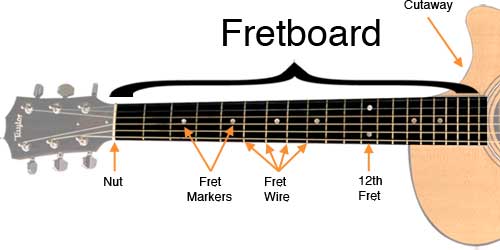I would actually suggest that there is no simple way to memorise which fret is which note because there's really too many. However, there are ways to make the process of identifying the note simpler/easier.
Let's take a look at the fretboard of a guitar below:

Here are some tips that I would suggest to help you remember the guitar fret board a little easier.
1. Remember the tuning of the guitar
--------------------------------------
In this case, it is standard tuning EADGBE (shown on the right of the diagram). This is very important because knowing what note you're playing when you play a free string helps tremendously.
2. Know your alphabets
------------------------
The notes on your guitar fretboard is like saying your alphabets. For music, it's from A to G. So, lets look at the 6th string, the one on top (E). To every note, there is a sharp (#). The only 2 exceptions are E and B. So, we see in the diagram that the free string for the 6th string is E, followed by F (remember there's no such thing as E#), then F#, then G, G#, A, A#, B, C (remember there's no such thing as B#), C#, D, D# and finally back to E (this note is one octave higher than the free string E). Notice it's just like reciting your alphabets? A B C D E F G. The only difference is you add in the sharps for notes that have them.
3. Apply the same "formula" for the other strings
-------------------------------------------------
This is why knowing your guitar tuning is important. The 5th string free string is an A note. So, apply the same "formula" to figure out what the other notes are. Free string is A, followed by A#, B, C, C#, D, D#, E, F, F#, G, G# and finally back to A again (one octave higher than the free string A).
4. Use "anchors"
--------------------
Knowing all this is good, but the best way to remember (I've realised), is to use what I term as "anchors". An anchor is something that holds a ship to a spot in the sea. In the same way, all you need to know are certain frets on the guitar and their notes. From these "anchors" you can know the other notes. For example, if you know that the 6th string 3rd fret is a G, then you'll also know that a F# is the 6th string 2nd fret, and a G# is the 6th string 4th fret. Also, if you know that the C is on the 5th string 3rd fret, then you'll also know that a B is the 5th string 2nd fret, and a C# is the 5th string 4th fret.
To remember these "anchors", you can use the dots (fret markers) on your guitar to help you (most guitar have them). They are commonly placed on the 3rd, 5th, 7th, 9th and 12th frets of the guitar like shown in the picture below:

These 4 tips should be able to help you out with your guitar fretboard.

At this point, I'd just like to talk about the first diagram again. I still haven't explained the chords that are in brackets. This is actually just to tell you that a F# can also be known as a Gb, G# can be known as an Ab, A# can be known as a Bb and so on.
So, if you happen to see in some chordbooks Eb, Db, Bb, Ab or Gb, don't be surprised. An easy way remember this is that every chord has a sharp and flat (only E and B does not have sharps). So, lets say you're at 6th string 3rd fret which is a G. If you move to the 4th fret, it's a G# or Ab, if you move to the 2nd fret, it's a F# or Gb.
I know it's quite confusing, so just remember one or the other. This information was just to let you know that there are sharps and flat.
I hope this post has been useful. If you have any questions to clarify, feel free to post a response.
5 comments:
Thanks for these... Great work! ^_^
so simple. Thanks so much. God bless you. so helpful
So sorry. Anyway, that was a simple lesson but very well explained and SO helpful. Thanks and God bless you!
Every teacher should be as clear and as organized. Thanks.
Post a Comment